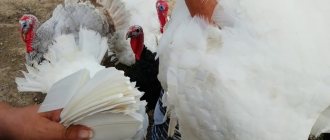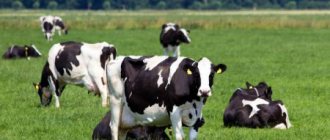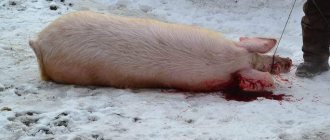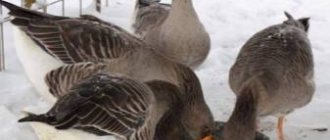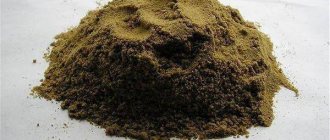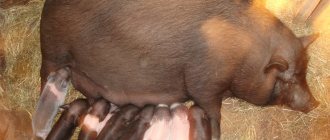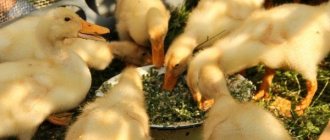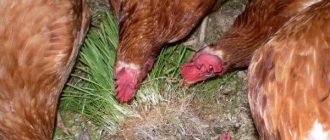Pig feed quantity
To effectively gain muscle mass in pig farming, special feed is used. In most cases, they are represented by concentrates of grain crops, vegetables, and herbaceous plants. However, to fully absorb all nutrients, the animal must drink enough water.
To ensure the constant growth of each individual in the herd, a correct calculation of the daily amount of food is required. Without knowing how much feed you need to raise a pig, you may not achieve the desired result (if there is a lack of nutrition) or provoke the development of stomach and intestinal problems in the pig (if there is an excess of feed).
Factors influencing how much feed a pig needs for fattening:
- initial weight – to effectively control the indicator, you need to weigh the animal once a month;
- age;
- floor.
The daily amount of feed for a pig directly depends on its age. So, during the milk period the following rules apply:
- animal up to 14 days - 25 g per day;
- piglet 30 days old - 350 g per day;
- two-month pig - 850 g per day.
At the growing stage for fattening, the pig needs to eat the following amount of feed per day:
- 3 months - 1 kg and 50 g;
- 4 months - one and a half kilograms.
Next comes the stage of fattening the animals. This is the period of the most active weight gain, the goal of which is to achieve slaughter weight for the animal (100 kg). When using high-quality feed, this indicator can be achieved in 6-8 months. From such an individual, the pig farmer receives 70-75 kg of clean meat.
Standards for how much feed a pig needs for fattening during this period (per 1 day):
- 5-month-old individual - 2 kg 250 g;
- six-month-old individual - 2 kg 550 g;
- animal at 7 months - 3 kg 200 g;
- pig at eight months - 3 kg 350 g.
For pig farmers, information indicating the feed standards that one individual eats in 12 months is also important:
- individuals under 2 months of age - from 145 to 175 kg;
- piglets up to 120 days – 490 – 580 kg;
- six-month-old animals - from 900 to 1100 kg;
- adult pigs – from 1450 to 1700 kg;
- sows - from 1500 to 1800 kg.
The composition of AgroVitEx feed is optimally balanced and can be used at any period of a piglet’s life. The mixture contains proteins, fats, carbohydrates, vitamins and microelements. Animals in the process of gaining weight will practically not need additional complementary foods.
Causes of poor appetite
Since pigs are known for their food addiction, it will be very easy to notice that something is wrong if the animal suddenly begins to eat less or refuses food altogether.
To fix this problem, you need to identify the causes. Most often, the cause of loss of appetite is the development of various kinds of diseases, to determine the nature and severity of which it is necessary to show the pig to a veterinarian. Only a professional doctor can determine the nature of the disease and prescribe the correct treatment. In addition to diseases, loss of appetite can be caused by a lack of vitamin D in the body, a sudden change in diet, or insufficient fluid intake. That is why it is necessary to provide the animal with a suitable vitamin complex and the required amount of water, as well as gradually change the diet, introducing new products or removing old ones. To restore the vitamin balance in the body, increasing the amount of fresh greens or hay will often be enough.
For information on what and how to feed pigs correctly, watch the following video.
Additional feeding
Compound feed "AgroVitEx" is the optimal solution for fattening pigs. However, in some cases, animals need additional feeding to achieve results. It is important to remember some rules:
- Any grain products must be crushed before being placed in the animal trough. In this form they are easier to digest. In addition, the individual eats more food, since whole grains can spill out of the mouth.
- The potatoes must first be washed and boiled.
- Vegetables can be given raw. However, when the percentage of root vegetables in the diet increases, they must first be boiled.
Peas, potatoes, barley, and clover improve the quality of the muscles of piglets and the taste of meat after slaughter. Therefore, whenever possible, these products should be included in the animal’s diet.
Nutritional Features
It will be useful for anyone involved in breeding pigs to know some feeding features:
1. It is better to feed livestock grain in crushed form, so digestibility will be much faster.
2. If potatoes are used in the diet, it is better to wash them before feeding them to get rid of dirt on them, and only then boil them. When boiled, it is better absorbed.
3. If root vegetables are included in the diet, then it is better to give them boiled if they are used as the main food. If they are given to animals in the form of vitamins, it is recommended to give them raw.
Feeding mode
Depending on the age of the individual, the frequency of meals can be three times a day (for the dairy period) or two times a day (for young and mature individuals). To gain weight as quickly as possible, it is recommended for animals to feed them with mixed feed that is balanced in nutritional composition. It is also possible to use food waste, but in this case it will not be possible to quickly fatten the piglet.
Conventionally, there are 2 modes of feeding animals:
- Wet (regular, traditional). In this case, mash is mainly used - a mixture of vegetables, food waste, grain crops, trauma and hay.
- Dry. The emphasis is on mixed feed, various mixtures of grain crops. With this type of feeding, one important condition applies - you need to give the animals enough water. Otherwise, constipation develops and the rate of weight gain decreases.
Today, in 80-85% of cases, pig farmers choose the second feeding mode. It does not require constant cooking of mash. The main thing is to first calculate the amount of feed required (according to the information given above), mix it with additional components and pour it into the trough.
In addition, dry feeding minimizes odor from the animal and speeds up the conversion of manure into fertilizer. This diet ensures rapid weight gain for pigs, which makes it more popular among pig farmers.
Types of feed
Complete and concentrated feeds are produced to feed animals. The complete mixture is a basic nutrition and does not require the addition of any components.
The concentrate is an additive that is used in the preparation of feed. It contains a high percentage of vitamins and minerals. Such feed is necessary to ensure the active development of pigs.
The following types of combined mixtures are distinguished:
The finished mixture may contain more than 35 different components, depending on the purpose of the feed. And also for the rapid growth of livestock, premixes are added to the feed. These mixtures contain vitamins, salt, and antibacterial drugs. Thanks to this nutrition, the need for basic feed is significantly reduced.
Feed granulator prices
Table 1. Percentage ratio of feed components depending on the weight of the animal
You should not feed pigs food with a high content of oats - such food is difficult to digest in the body
Ready-made combined mixtures for pigs usually contain about 10-12 different components, the main part being grain. For such purposes, corn grits, barley, oats and wheat are used. It also contains fats, fishmeal, salt, yeast, and cake.
Types of pig fattening
The amount of feed when fattening a pig, the frequency of food consumption and other factors affect the final result. Depending on the goal set by the pig breeder, it is recommended to use the following types of fattening:
- Meat. The goal is to increase the animal's muscle mass.
- Bacon. The goal is to get meat with an even layer of fat.
- Fattening for lard. The goal is to increase the fat mass of the animal.
Good options for quick weight gain (meat type) are feed containing potatoes, peas, and corn. They are well absorbed in the animal's body. To gain weight quickly, you also need to provide the appropriate amount of microelements and minerals. A pig eats up to 30 g of crushed chalk (calcium), about 25 g of salt and another 10-20 g of phosphorus per day.
When preparing an animal for bacon, food is used that increases the mass and quality of the meat. Pet food should not contain more than 4% fat due to the deterioration of bacon. Large amounts of cake and oats should be avoided. At the second stage, preference should be given to feed containing barley and millet concentrates. Juicy food options include beets and potatoes. Dairy products are also good.
For fattening pigs in order to obtain a large amount of fat, a feeding option with and without a preliminary preparatory stage is used. Preparation involves increasing the diet of young piglets with succulent and roughage feed, as well as green grass, which is available in the summer. The emphasis is on waste from grain crops, mill dust and others.
The second stage begins after the pig has gained 100-120 kg. The amount of concentrated feed in the diet increases. It is worth remembering that during this period, animals often lose their appetite. It is important to try to achieve 100% of your daily food intake. To do this, food is flavored with flavoring and aromatic additives, the feeding order is changed, and the like.
How to prepare compound feed?
Buying ready-made feed is a rather expensive undertaking. Sometimes farmers prefer to prepare their own mixtures for fattening their livestock. You will need to purchase all individual components in advance.
Making feed yourself is easy
The main purpose of fattening adult pigs is to obtain meat and lard. Therefore, grain feed should be present in the diet. Compound feed is prepared for pregnant pigs based on one ground cereal. To prepare the feed mixture you will need the following components:
- oats – 250 g;
- barley – 350 g;
- fish meal – 130 g;
- alfalfa flour – 115 g;
- sunflower cake – 75 g;
- table salt – 8 g;
- chalk – 8 g.
This food is suitable for fattening livestock for 12 months. From such components you can prepare a liquid porridge or make granules.
Feed crusher
Growing piglets only need ground feed or granules. It is advisable to give liquid feed to young animals, because such nutrition is better absorbed by the body. The temperature of the porridge should be about 35-36 degrees.
Preparation of mixture for piglets includes the following components:
- barley – 800 g;
- yeast – 85 g;
- fat (feed) – 85 g;
- chalk – 12 g;
- salt – 4 g.
The cereal should be thoroughly ground in a crusher. And then add the remaining ingredients to the food and mix. To increase the energy value, boiled potato tubers and bread are added to the composition.
Table 3. Independent preparation of feed
Diet for the milk period
The diet of a fattening pig during the dairy period determines the rate at which the individual gains muscle mass. Nutritional features at this stage:
- The piglet receives complementary feeding only on the 5th day. Until then, he remains on mother's milk.
- Peas, barley and corn are used first in complementary feeding. These products help accelerate tooth growth and improve the functioning of the salivary glands.
- To normalize the functioning of the gastrointestinal tract, special yogurt is used.
- From the 14th day, compound feed is added, which helps accelerate the growth of the individual.
- Grated chalk is a part of the diet that improves the condition of the animal’s bones. The daily norm is 2 g.
- To normalize intestinal function and minimize the risk of developing gastrointestinal diseases, charcoal is added to the diet of piglets.
- At the age of 40-50 days, the piglet is separated from its mother and gradually accustomed to the appropriate type of food (wet or dry). The transition period takes on average 10 days.
The amount of feed for raising a pig during the dairy period is calculated according to the rules indicated above.
What should you not feed piglets?
Although Vietnamese piglets are not picky about food, experienced livestock farmers advise adhering to the basic recommendations for preparing a diet:
Due to their small stomach, they eat often, but in small portions. This allows food to be digested faster
You also need to take into account the fact that their stomach does not process coarse feed well.
For normal processing and absorption of food by the body, the amount of saliva that is released during chewing is important. Therefore, food that is too liquid should also not be given.
It is better if it is porridge with the addition of fruits, vegetables, and herbs, which are finely chopped. You can also add chopped products such as apples, pears, pumpkin, zucchini, cereals, and carrots.
Pot-bellied pigs need constant walking in the fresh air. It is advisable if it is an area with greenery or weeds.
It is not allowed to add large amounts of roughage, which has a lot of fiber, to the diet. The same applies to fodder beets, straw, hay, and pulp.
Any vitamin food or mineral feed cannot be heat treated. This reduces the amount of nutrients.
Purpose of cultivation
Before starting to breed animals, the pig breeder must decide on the goals of the work. The choice of diet for animals, the amount of feed, as well as additional components of the diet depend on this. AgroVitEx offers farmers a full range of feeds for productive and balanced nutrition of pigs of different ages.
An adequate amount of combined feed for fattening pigs reduces the risk of developing gastrointestinal diseases and accelerates the achievement of slaughter weight. Calculation of the required amount of feed must be carried out even before the start of breeding. Simplicity in calculations and high quality of pig meat after slaughter are important features of AgroVitEx compound feeds.
Nutrient requirements for piglets
Nutritional requirements for compound feed for piglets at 88% dry matter, DLG, 2008
*) dietary feed for feeding piglets in case of diarrhea (for a limited time)
**) lysine : met+cis : threonine : tryptophan = 1 : 0.53 : 0.63 : 0.18
***) digestibility in the intestine 90%
****) using phytase
It is necessary to feed piglets so that they receive a sufficient amount of macro- and microelements, as well as vitamins.
The requirement of piglets for macro- and microelements is presented here.
See the vitamin requirements of piglets here.
During weaning, piglets continue to be fed prestarter, and then are gradually transferred to compound feed after weaning or to compound feed during growing I.
Prohibited Products
Pigs should not be fed:
- Products with traces of mold, parasites, fungi.
- Herbs that can cause poisoning. One-month-old piglets should not be fed: horse dill;
- black nightshade;
- caustic buttercup;
- milkweed;
- hemlock;
- dog parsley.
To fatten a pig at home, you will have to tinker. If you don’t listen to the advice of experienced pig breeders, you risk wasting more feed than you need and getting low-quality products. Get ready to strictly adhere to the diet and diet, and then breeding pigs will bring you the desired profit.
0
0
Copy link
